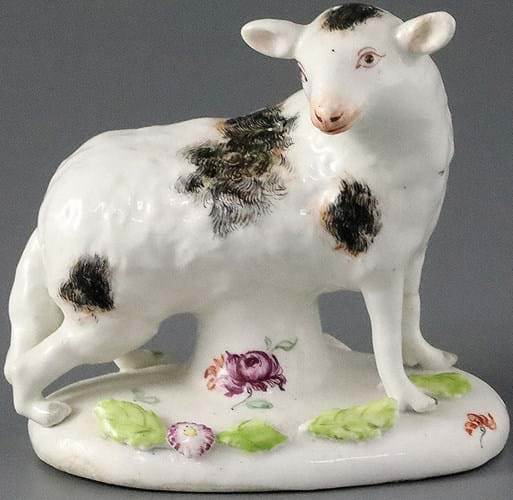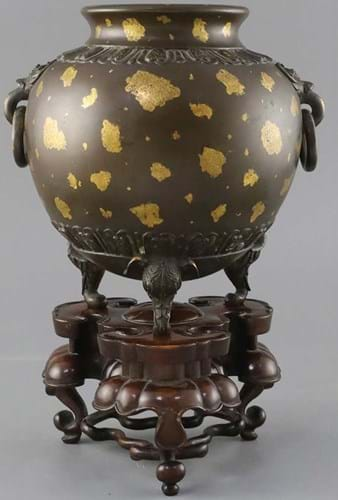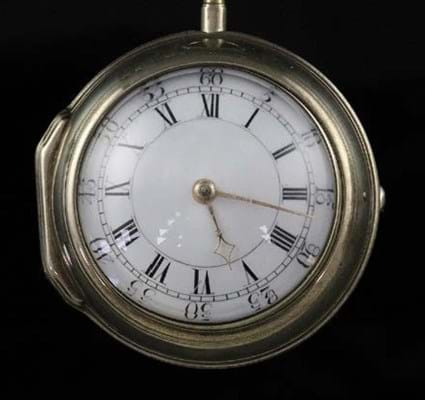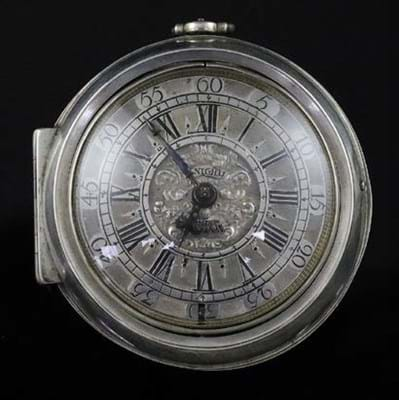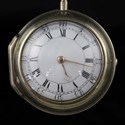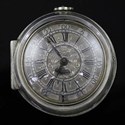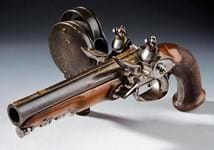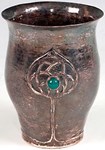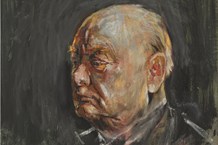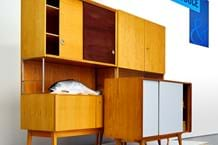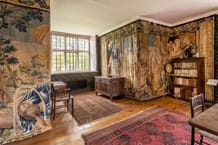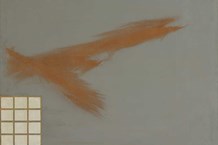The September 1 auction at Gorringe’s (23% buyer’s premium) in Lewes was an amalgam of a cancelled June sale and an autumnal event traditionally held in October.
At 721 lots it was smaller than the 2019 events, but a winnowing process made, in part, to allow for the slightly slower online bidding, paid dividends. The 84% selling rate and £849,000 hammer total was proof enough of the success of the refining process, believed auctioneer Dan Bray.
Vast collection
A major draw for English collectors were further pieces from the collection of published 18th and 19th century English porcelain specialist Dr Dennis G Rice.
Elements from a vast collection have been dispersed in three sales at Lewes over the past 16 months.
Here a rare c.1752 Longton Hall 3¾in (9.5cm) long figure of a ewe, with some restoration and losses doubled top estimate at £1600 while a c.1760-65, (14.5cm) high Vauxhall group of two Bacchanalian cherubs and a goat tripled the mid-estimate at £1200.
Best of 13 pieces of early Derby was a ‘pale family’ type flute player. Dated c.1756-58, the 6½in (16.5cm) figure with small losses was estimated at £200-300 and sold at £460.
That price was exceeded by a later rare 4in (10cm) tall model of horses dated c.1819-25. With some restoration to one horse and flaking to the other, the figures made £750, five times the lower estimate.
This was perhaps a good omen for the final tranche of the collection – more of Dr Rice’s many English ceramic animals which will be offered at future weekly sales.
Entered by other vendors, early Worcester struggled but a c.1752-54, 6in (15.5cm) wide Chelsea strawberry sauceboat sold on the lower estimate at £2000 via thesaleroom.com.
Twentieth century material fared better. A c.1925, 13½in (34cm) tall Ruskin high-fired lilac, lavender and green speckled vase was in good condition and quadrupled the mid-estimate in selling at £2400.
Ravilious bowl
Eric Ravilious (1903-42) worked with Wedgwood from 1936-40, decorating a 12in (30.5cm) diameter Boat Race bowl with scenes of Oxford and Cambridge races to the exterior and Piccadilly Circus to the interior.
It was in excellent condition – indeed Gorringe’s vendor had thought it to be one of the 1970s limited edition before being told it was an original – with black printed and impressed manufacture’s marks and the red code CL6263. Against a £1500-2000 estimate, it sold to an overseas bidder at £2600.
Dame Lucie Rie’s 10in diameter x 3½in tall (25.5 x 9cm) stoneware footed bowl, with trademark bronzed manganese and brown band running into a pitted beige and cream glaze, came with a undated receipt from the Casson Gallery for its sale at £120. At Gorringe’s it went within estimate at £8000 to an English collector on thesaleroom.com.
Lotus flower jar
More competition emerged for a doucai lotus flower jar with six-character Wanli mark and probably of period (1573-1619). Standing 3¾in (9.5cm) tall and on a later wooden base, the jar had a gilt-filled repair to a large section of the rim and a hairline crack along the luting line but otherwise was in reasonable condition. Pitched at £800-1200, it took £29,000.
As with the other leading Chinese pieces, it went back to the mainland. Best of the jade was a late Qing white and russet jade group of Xi Wangmu and a phoenix. Standing 3¾in (9.5cm) tall and on a wooden stand, it took a six-times-estimate £9000.
Topping the Chinese material was an 18th century gold-splashed tripod vessel with an apocryphal Xuande two-character seal mark. With bat-mask ring handles and feet formed as elephants’ heads, the 7½in (19.5cm) tall vessel on a Qing dynasty triple ruyi head hardwood stand went to a buyer via thesaeleroom.com at £32,000, more than five times the top estimate.
Bronze tackled
It was a good day for bronze. Tackled, a 21in (53cm) long Fine Art Society casting of the 1932 plaster original of rugby players by Muriel Joyce Bidder (1906-99), went to a collector against London trade rivals at a ten-times top-estimate £8000.
Two Russian bronzed cast-iron figures of Hercules standing holding a large rock were also popular. With indistinct signatures and undated in the catalogue, the 15¾in (40cm) tall figures were in fair condition and against a £250-350 estimate attracted Russian interest and went to an overseas bidder at £2000.
Also going abroad was a rare 18th century white and brown walrus ivory Russian chess set, with 2¾in (7cm) tall kings on thrones. Depicting Russian troops against Persians, the mahogany boxed set estimated at £2800-3200 made £4800.
Frodsham timepiece
Topping the horology was a 20th century brass-cased humpback carriage timepiece made for Frodsham by Philip Thornton (1916-75). Signed Frodsham, London to the silvered dial, which featured a lunar calendar (the base had a perpetual calendar), the 8in (20cm) tall clock sold back to the venerable and going-strong Frodsham company, comfortably over estimate at £8500.
One of the greatest ‘Golden Age’ clockmakers, George Graham, and his hugely regarded, if less well known, contemporary Michael Knight were more affordable. Both were represented by less-than-perfect, silver pair-cased pocket watches.
A c.1744 cylinder watch, No 6144, was signed to the movement by Graham and made £2200. That was around the norm for a Graham watch but nearly five times the mid-estimate. A longcase by Knight can easily make five figures but the £2800 bid online for his signed 18th century 2¼in (6cm) diameter verge watch was well above the pitch of £150-250.
Twentieth century material led the silver – a 10-piece silver, coral and black enamel-mounted dressing table set by Cartier Ltd. London 1934 which took a triple top-estimate £6000.
Furniture promising signs
Bray says he detects signs of resurgence in the antique furniture market and a pair of late Victorian satinwood dwarf bookcases stamped Holland & Sons went well above hopes of £1000-1500, making £3800.
Looks rather than age, however, remain a key factor. A 1930s ‘Queen Anne revival’ walnut display cabinet, 4ft 10in (1.48m) tall with two barred glazed doors flanking a central glazed section above drawers, made a six-times estimate £3000.
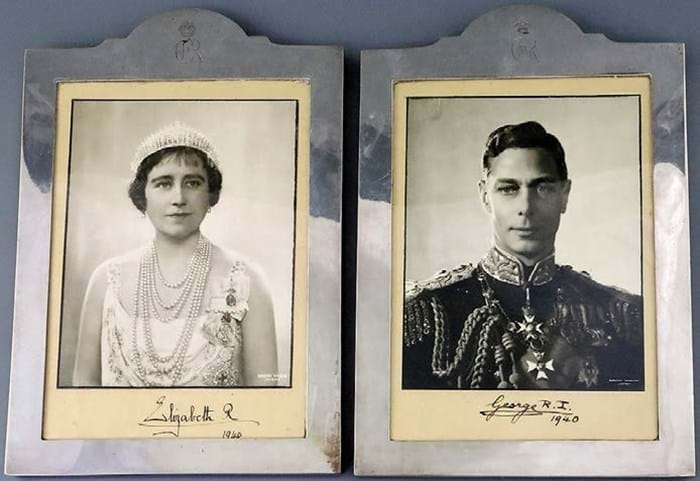
Pair of signed and dated 1940 presentation photographs, Elizabeth R and George RI, by Dorothy Wilding – £9500 at Gorringe’s.
Coming from the deceased estate of a private admirer, a small collection of royal photographs from the 1930s-40s offered in three lots took £14,700 against a top estimate of £1400.
Best by a distance was a pair of signed and dated 1940 presentation photographs. Taken by snapper to the stars and royal favourite Dorothy Wilding (1893-1976), who later took the iconic picture of Elizabeth II used on postage stamps from 1942-67, the photos were in 12½in x 8½in (32 x 21.5cm) crested silver frames. Estimated at £300-500, the pair sold to a local collector at £9500


